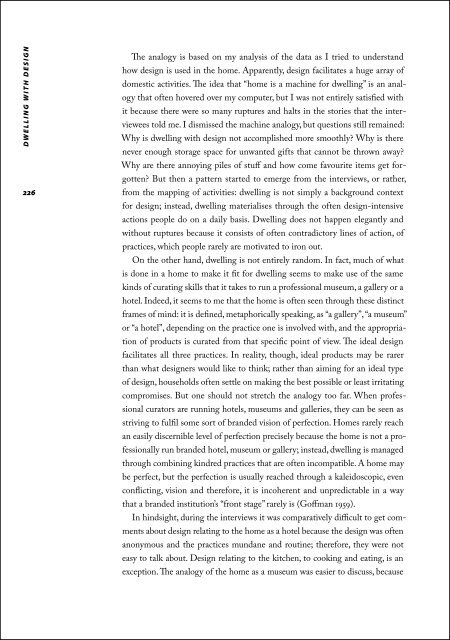Lataa ilmaiseksi
Lataa ilmaiseksi
Lataa ilmaiseksi
Create successful ePaper yourself
Turn your PDF publications into a flip-book with our unique Google optimized e-Paper software.
D W E L L I N G W I T H D E S I G N<br />
226<br />
The analogy is based on my analysis of the data as I tried to understand<br />
how design is used in the home. Apparently, design facilitates a huge array of<br />
domestic activities. The idea that “home is a machine for dwelling” is an analogy<br />
that often hovered over my computer, but I was not entirely satisfied with<br />
it because there were so many ruptures and halts in the stories that the interviewees<br />
told me. I dismissed the machine analogy, but questions still remained:<br />
Why is dwelling with design not accomplished more smoothly? Why is there<br />
never enough storage space for unwanted gifts that cannot be thrown away?<br />
Why are there annoying piles of stuff and how come favourite items get forgotten?<br />
But then a pattern started to emerge from the interviews, or rather,<br />
from the mapping of activities: dwelling is not simply a background context<br />
for design; instead, dwelling materialises through the often design-intensive<br />
actions people do on a daily basis. Dwelling does not happen elegantly and<br />
without ruptures because it consists of often contradictory lines of action, of<br />
practices, which people rarely are motivated to iron out.<br />
On the other hand, dwelling is not entirely random. In fact, much of what<br />
is done in a home to make it fit for dwelling seems to make use of the same<br />
kinds of curating skills that it takes to run a professional museum, a gallery or a<br />
hotel. Indeed, it seems to me that the home is often seen through these distinct<br />
frames of mind: it is defined, metaphorically speaking, as “a gallery”, “a museum”<br />
or “a hotel”, depending on the practice one is involved with, and the appropriation<br />
of products is curated from that specific point of view. The ideal design<br />
facilitates all three practices. In reality, though, ideal products may be rarer<br />
than what designers would like to think; rather than aiming for an ideal type<br />
of design, households often settle on making the best possible or least irritating<br />
compromises. But one should not stretch the analogy too far. When professional<br />
curators are running hotels, museums and galleries, they can be seen as<br />
striving to fulfil some sort of branded vision of perfection. Homes rarely reach<br />
an easily discernible level of perfection precisely because the home is not a professionally<br />
run branded hotel, museum or gallery; instead, dwelling is managed<br />
through combining kindred practices that are often incompatible. A home may<br />
be perfect, but the perfection is usually reached through a kaleidoscopic, even<br />
conflicting, vision and therefore, it is incoherent and unpredictable in a way<br />
that a branded institution’s “front stage” rarely is (Goffman 1959).<br />
In hindsight, during the interviews it was comparatively difficult to get comments<br />
about design relating to the home as a hotel because the design was often<br />
anonymous and the practices mundane and routine; therefore, they were not<br />
easy to talk about. Design relating to the kitchen, to cooking and eating, is an<br />
exception. The analogy of the home as a museum was easier to discuss, because
















